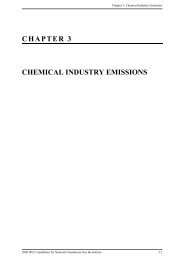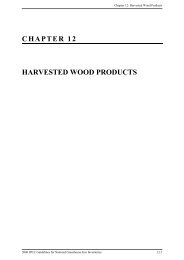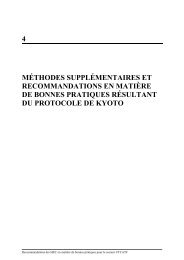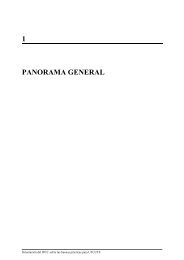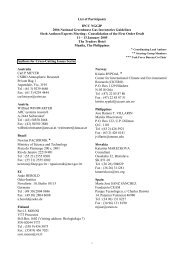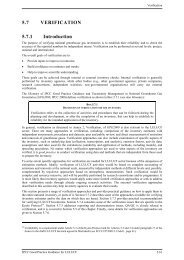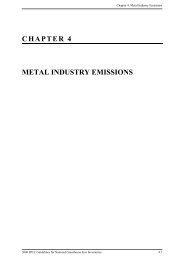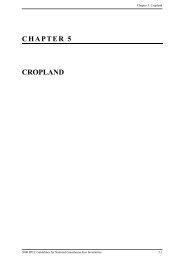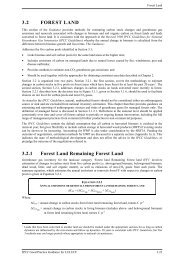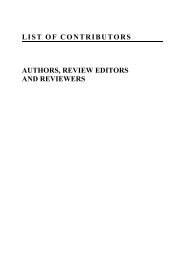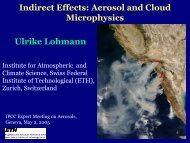2006 IPCC Guidelines - IPCC - Task Force on National Greenhouse ...
2006 IPCC Guidelines - IPCC - Task Force on National Greenhouse ...
2006 IPCC Guidelines - IPCC - Task Force on National Greenhouse ...
You also want an ePaper? Increase the reach of your titles
YUMPU automatically turns print PDFs into web optimized ePapers that Google loves.
<str<strong>on</strong>g>IPCC</str<strong>on</strong>g> NATIONAL GREENHOUSE GAS INVENTORIES PROGRAMME<br />
despite widely varying levels of resources and expertise.<br />
These methods and parameters can also be used within<br />
the structure of the previous <str<strong>on</strong>g>Guidelines</str<strong>on</strong>g>.<br />
The use of the <str<strong>on</strong>g>2006</str<strong>on</strong>g> <str<strong>on</strong>g>IPCC</str<strong>on</strong>g> <str<strong>on</strong>g>Guidelines</str<strong>on</strong>g> will facilitate<br />
reliable, complete nati<strong>on</strong>al estimati<strong>on</strong> of emissi<strong>on</strong>s and<br />
removals that are c<strong>on</strong>sistent over time and comparable<br />
Fuel Combusti<strong>on</strong><br />
Categories Added since the Previous <str<strong>on</strong>g>Guidelines</str<strong>on</strong>g><br />
Other Uses of Fluorinated Gases<br />
CO 2 - Transport and Storage Electrical Equipment<br />
Urea-based Catalysts (Road Transport) Military Applicati<strong>on</strong>s<br />
Fugitive Emissi<strong>on</strong>s from Fuels<br />
Accelerators<br />
Aband<strong>on</strong>ed Underground Mines Medical Applicati<strong>on</strong>s<br />
Mineral Industry<br />
Glass Producti<strong>on</strong><br />
Ceramics<br />
Propellant for Pressure and Aerosol Products<br />
Oz<strong>on</strong>e Depleting Substances Substitutes<br />
Land Use<br />
N<strong>on</strong> Metallurgical Magnesia Producti<strong>on</strong> Complete, c<strong>on</strong>sistent treatment of fi res<br />
Chemical Industry Liming<br />
Caprolactam, Glyoxal & Glyoxylic Acid Producti<strong>on</strong> Urea Applicati<strong>on</strong><br />
Titanium Dioxide Producti<strong>on</strong><br />
Petrochemical and Carb<strong>on</strong> Black Producti<strong>on</strong><br />
Metal Industry<br />
Waste<br />
Indirect N 2 O Emissi<strong>on</strong>s from Manure Management<br />
Harvested Wood Products (methods now provided)<br />
Lead Producti<strong>on</strong> Biological Treatment of Solid Waste<br />
Zinc Producti<strong>on</strong> Open Burning of Waste<br />
Electr<strong>on</strong>ics Industries<br />
Other<br />
Integrated Circuit or Semic<strong>on</strong>ductor Indirect N 2 O Emissi<strong>on</strong>s from the Atmospheric Depositi<strong>on</strong><br />
TFT Flat Panel Display<br />
Photovoltaics<br />
Heat Transfer Fluid<br />
of NO x and NH 3 (excluding agricultural sources)<br />
The <str<strong>on</strong>g>2006</str<strong>on</strong>g> <str<strong>on</strong>g>IPCC</str<strong>on</strong>g> <str<strong>on</strong>g>Guidelines</str<strong>on</strong>g> are available as free download from our web site:<br />
http://www.ipcc-nggip.iges.or.jp/<br />
This site also c<strong>on</strong>tains earlier editi<strong>on</strong>s of the <str<strong>on</strong>g>IPCC</str<strong>on</strong>g> <str<strong>on</strong>g>Guidelines</str<strong>on</strong>g> and supporting material such as the Emissi<strong>on</strong>s Factor Database.<br />
A CDROM versi<strong>on</strong> is also available for those with problems downloading the fi les. The <str<strong>on</strong>g>Guidelines</str<strong>on</strong>g> have been translated into all UN<br />
languages and these are also available <strong>on</strong> the website.<br />
Technical Support Unit of the <str<strong>on</strong>g>IPCC</str<strong>on</strong>g> <str<strong>on</strong>g>Task</str<strong>on</strong>g> <str<strong>on</strong>g>Force</str<strong>on</strong>g> <strong>on</strong> Nati<strong>on</strong>al <strong>Greenhouse</strong> Gas Inventories<br />
Institute for Global Envir<strong>on</strong>mental Strategies (IGES), 2108-11 Kamiyamaguchi, Hayama, Kanagawa, 240-0115 Japan<br />
Tel: +81-46-855-3750<br />
Fax: +81-46-855-3808<br />
mail: http://www.ipcc-nggip.iges.or.jp/mail<br />
TSU Head: Dr. Sim<strong>on</strong> Egglest<strong>on</strong><br />
between countries. Their use will make inventories more<br />
transparent and accurate.<br />
They are available for free download from the NGGIP<br />
website and users are encouraged to print and distribute<br />
them widely.<br />
<str<strong>on</strong>g>IPCC</str<strong>on</strong>g> NATIONAL GREENHOUSE GAS INVENTORIES PROGRAMME<br />
INTERGOVERNMENTAL PANEL ON CLIMATE CHANGE<br />
NATIONAL GREENHOUSE GAS INVENTORIES PROGRAMME<br />
<str<strong>on</strong>g>2006</str<strong>on</strong>g> <str<strong>on</strong>g>IPCC</str<strong>on</strong>g> <str<strong>on</strong>g>Guidelines</str<strong>on</strong>g><br />
for Nati<strong>on</strong>al <strong>Greenhouse</strong> Gas Inventories<br />
The <str<strong>on</strong>g>2006</str<strong>on</strong>g> <str<strong>on</strong>g>IPCC</str<strong>on</strong>g> <str<strong>on</strong>g>Guidelines</str<strong>on</strong>g> for Nati<strong>on</strong>al <strong>Greenhouse</strong> Gas<br />
Inventories (<str<strong>on</strong>g>2006</str<strong>on</strong>g> <str<strong>on</strong>g>Guidelines</str<strong>on</strong>g>) have now been published.<br />
They are freely available either <strong>on</strong> CDROM or can be<br />
downloaded from internet.<br />
http://www.ipcc-nggip.iges.or.jp/<br />
The <str<strong>on</strong>g>2006</str<strong>on</strong>g> <str<strong>on</strong>g>Guidelines</str<strong>on</strong>g> are a signifi cant step forward in the<br />
producti<strong>on</strong> of high quality nati<strong>on</strong>al estimates of emissi<strong>on</strong>s<br />
and removals of greenhouse gases. They are the result of<br />
the work of over 250 authors over 2 years, and have been<br />
extensively peer-reviewed. They build <strong>on</strong> over 10 years of<br />
inventory development work by the <str<strong>on</strong>g>IPCC</str<strong>on</strong>g> and experience<br />
gained in using earlier <str<strong>on</strong>g>IPCC</str<strong>on</strong>g> guidance. The Revised 1996<br />
<str<strong>on</strong>g>IPCC</str<strong>on</strong>g> <str<strong>on</strong>g>Guidelines</str<strong>on</strong>g> for Nati<strong>on</strong>al <strong>Greenhouse</strong> Gas Inventories<br />
(Revised 1996 <str<strong>on</strong>g>Guidelines</str<strong>on</strong>g>), together with the two volumes<br />
<strong>on</strong> inventory good practice (see Good Practice Guidance<br />
box) currently have to be used by so-called 'Annex I'<br />
Parties to the United Nati<strong>on</strong>as Framework C<strong>on</strong>venti<strong>on</strong><br />
<strong>on</strong> Climate Change (UNFCCC) (developed countries).<br />
All other Parties to the C<strong>on</strong>venti<strong>on</strong> should also use the<br />
Revised 1996 <str<strong>on</strong>g>Guidelines</str<strong>on</strong>g> while the use of the Good<br />
Practice Guidance is <strong>on</strong>ly encouraged. The UNFCCC is<br />
now c<strong>on</strong>sidering the new <str<strong>on</strong>g>2006</str<strong>on</strong>g> <str<strong>on</strong>g>Guidelines</str<strong>on</strong>g>.<br />
The <str<strong>on</strong>g>2006</str<strong>on</strong>g> <str<strong>on</strong>g>Guidelines</str<strong>on</strong>g> were reviewed by experts and<br />
governments twice before their acceptance by the <str<strong>on</strong>g>IPCC</str<strong>on</strong>g><br />
in Mauritius in April <str<strong>on</strong>g>2006</str<strong>on</strong>g>. Over 6000 comments from<br />
around the world were c<strong>on</strong>sidered by the authors. This<br />
widespread authorship and extensive review has ensured<br />
that the <str<strong>on</strong>g>Guidelines</str<strong>on</strong>g> c<strong>on</strong>tain the best available informati<strong>on</strong><br />
and guidance.<br />
While the <str<strong>on</strong>g>2006</str<strong>on</strong>g> <str<strong>on</strong>g>Guidelines</str<strong>on</strong>g> were developed in resp<strong>on</strong>se to<br />
a request by the Parties to the UNFCCC they can be used<br />
more widely (see Emissi<strong>on</strong> Inventories box). Therefore the<br />
<str<strong>on</strong>g>2006</str<strong>on</strong>g> <str<strong>on</strong>g>IPCC</str<strong>on</strong>g> <str<strong>on</strong>g>Guidelines</str<strong>on</strong>g> have been developed starting from<br />
<str<strong>on</strong>g>2006</str<strong>on</strong>g> <str<strong>on</strong>g>Guidelines</str<strong>on</strong>g> - C<strong>on</strong>tents<br />
Volume 1 – General Guidance and Reporting:<br />
gives general informati<strong>on</strong> <strong>on</strong> inventory compilati<strong>on</strong>, QA/QC, uncertainty and guidance <strong>on</strong> the choice of methods.<br />
Volume 2 – Energy:<br />
covers the use, producti<strong>on</strong> and transport of energy. Includes coverage of carb<strong>on</strong> dioxide capture and storage.<br />
Volume 3 – Industrial Processes and Product Use (IPPU):<br />
covers industrial processes such as metal producti<strong>on</strong>, petrochemicals and other chemical producti<strong>on</strong>. Also covers<br />
the use of products including fl uorinated gases.<br />
Volume 4 – Agriculture, Forestry and Other Land Use (AFOLU):<br />
integrates agriculture with all other land uses and changes in land use. Covers agricultural sources such as<br />
livestock, manure management and fertiliser use as well as emissi<strong>on</strong>s and removals of greenhouse gases from<br />
differing land uses such as forestry, grasslands and settlements.<br />
Volume 5 – Waste:<br />
covers the collecti<strong>on</strong>, treatment and disposal of wastes including solid wastes, landfi lls and waste water treatment.
<str<strong>on</strong>g>IPCC</str<strong>on</strong>g> NATIONAL GREENHOUSE GAS INVENTORIES PROGRAMME<br />
Sectoral Guidance<br />
Energy<br />
IPPU<br />
AFOLU<br />
Waste<br />
Data Collecti<strong>on</strong><br />
the previous 1996 <str<strong>on</strong>g>Guidelines</str<strong>on</strong>g>, the two volumes of Good<br />
Practice Guidance together with new scientific and technical<br />
knowledge to improve methods and default values of<br />
emissi<strong>on</strong> factors and other parameters. The usability of the<br />
new <str<strong>on</strong>g>Guidelines</str<strong>on</strong>g> in countries with limited resources and/or<br />
experience has been a major c<strong>on</strong>siderati<strong>on</strong> in the drafting<br />
process. The choice of methods by inventory compilers<br />
has been structured and made c<strong>on</strong>sistent throughout the<br />
<str<strong>on</strong>g>Guidelines</str<strong>on</strong>g> so that inventory compilers with c<strong>on</strong>siderable<br />
resources and expertise can use sophisticated methods<br />
while those with fewer resources can still use comparable<br />
good practice methods.<br />
Volume 1 of the <str<strong>on</strong>g>2006</str<strong>on</strong>g> <str<strong>on</strong>g>Guidelines</str<strong>on</strong>g> provides an overview of<br />
the management and process of developing inventories<br />
while the remaining volumes give sector specifi c guidance<br />
(see the fi gure above).<br />
General Guidance & Reporting<br />
Uncertainties<br />
Methodological Choice<br />
Key Categories<br />
Relati<strong>on</strong>ship between General and Sectoral Guidance<br />
Major Improvements<br />
In additi<strong>on</strong> to the many improvements to default values and<br />
individual methods the <str<strong>on</strong>g>2006</str<strong>on</strong>g> <str<strong>on</strong>g>IPCC</str<strong>on</strong>g> <str<strong>on</strong>g>Guidelines</str<strong>on</strong>g> include a<br />
number of major improvements. The table overleaf shows<br />
the categories added since the earlier guidance. The<br />
<str<strong>on</strong>g>2006</str<strong>on</strong>g> <str<strong>on</strong>g>Guidelines</str<strong>on</strong>g> have been restructured compared to the<br />
Revised 1996 <str<strong>on</strong>g>Guidelines</str<strong>on</strong>g>.<br />
Two new sectors have been created by the amalgamati<strong>on</strong><br />
of previously separate sectors:<br />
Industrial Process and Product Use (IPPU)<br />
combining Industrial Processes and Solvent and<br />
Other Product Use Sectors<br />
Agriculture, Forestry and Other Land Use (AFOLU)<br />
combining Agriculture with Land Use, Land-Use<br />
Change and Forestry (LULUCF) Sectors.<br />
Emissi<strong>on</strong> Inventories<br />
Nati<strong>on</strong>al <strong>Greenhouse</strong> Gas Inventories are complete estimates of the anthropogenic annual emissi<strong>on</strong>s and removals<br />
of greenhouse gases from a country developed source-by-source and sink-by-sink. Inventories are a valuable tool for<br />
many users. Not <strong>on</strong>ly are they needed for reporting greenhouse gas emissi<strong>on</strong>s, they are a key input to policy makers<br />
and also to developing the scientifi c understanding of climate change. Good knowledge of emissi<strong>on</strong>s and removals of<br />
greenhouse gases:<br />
enables reducti<strong>on</strong> policies to be developed in a cost effective way,<br />
allows different policy opti<strong>on</strong>s to be compared,<br />
provides a simple m<strong>on</strong>itoring mechanism to m<strong>on</strong>itor implementati<strong>on</strong> of these policies,<br />
are a key input to scientifi c studies of many envir<strong>on</strong>mental issues.<br />
Time Series C<strong>on</strong>sistency<br />
QA/QC<br />
Verificati<strong>on</strong><br />
Reporting<br />
Emissi<strong>on</strong><br />
Inventory<br />
Good Practice Guidance<br />
Good practice is a set of procedures intended to ensure that greenhouse gas inventories are accurate in the sense<br />
that they are systematically neither over- nor underestimates so far as can be judged, and that uncertainties are<br />
reduced so far as possible.<br />
Good practice inventories are:<br />
Transparent + Complete + Internally C<strong>on</strong>sistent +<br />
Comparable between countries + Accurate<br />
The two volumes <strong>on</strong> inventory good practice are: “Good Practice Guidance and Uncertainty Management in Nati<strong>on</strong>al<br />
<strong>Greenhouse</strong> Gas Inventories” and “Good Practice Guidance for Land Use, Land-Use Change and Forestry". These<br />
have now been updated and merged into the <str<strong>on</strong>g>2006</str<strong>on</strong>g> <str<strong>on</strong>g>Guidelines</str<strong>on</strong>g>.<br />
These combined sectors aim to reduce the risk of double<br />
counting, or omitting emissi<strong>on</strong>s, in these areas which<br />
naturally overlap.<br />
By combining the Good Practice Guidance into the main<br />
text the overall result is a clear, more c<strong>on</strong>sistent and<br />
systematic manual. Volume 1 provides extended good<br />
practice guidance applicable to all sectors with an extended<br />
introducti<strong>on</strong> providing an overview of emissi<strong>on</strong> inventory<br />
compilati<strong>on</strong>. The guidance <strong>on</strong> data collecti<strong>on</strong> has been<br />
expanded with a dedicated chapter in Volume 1.<br />
The guidance <strong>on</strong> the treatment of the n<strong>on</strong>-energy use<br />
of fuels has been revised with any emissi<strong>on</strong>s now being<br />
reported in the Industrial Processes and Product Use<br />
Sector.<br />
All emissi<strong>on</strong>s are now estimated as actual annual<br />
emissi<strong>on</strong>s. In earlier guidance some methods gave<br />
“potential” emissi<strong>on</strong>s, the total emissi<strong>on</strong>s from an annual<br />
activity that occur in the inventory year and into the future (for<br />
example emissi<strong>on</strong> of methane from landfills can occur for<br />
many years after the material is disposed of in the landfi ll).<br />
In the AFOLU Sector, previously opti<strong>on</strong>al categories, such<br />
as fi res, settlements and wetlands, have been c<strong>on</strong>solidated<br />
into the main guidance.<br />
Care has been taken in these <str<strong>on</strong>g>Guidelines</str<strong>on</strong>g> to ensure that all<br />
the CO 2 estimates are of CO 2 emitted directly (ignoring any<br />
carb<strong>on</strong> from the oxidati<strong>on</strong> in the atmosphere of other gases)<br />
thus improving the c<strong>on</strong>sistency between sectors.<br />
Other Assistance<br />
While the <str<strong>on</strong>g>IPCC</str<strong>on</strong>g> cannot provide training directly we are<br />
producing a number of tools and other support for users of<br />
the <str<strong>on</strong>g>2006</str<strong>on</strong>g> <str<strong>on</strong>g>Guidelines</str<strong>on</strong>g>. These include:<br />
Emissi<strong>on</strong> Factor Database (EFDB): a collecti<strong>on</strong> of<br />
emissi<strong>on</strong> factors and other parameters to assist users<br />
in finding the most appropriate emissi<strong>on</strong> factors for their<br />
nati<strong>on</strong>al circumstances. Users can download data for their<br />
own use and c<strong>on</strong>tribute by submitting new emissi<strong>on</strong> factors.<br />
Inventory Software is now being developed. This<br />
software will implement the tier 1 (and most tier 2) methods<br />
in a simple way while assisting some of the QA/QC<br />
requirements.<br />
NGGIP Website has copies of most of the publicati<strong>on</strong>s of<br />
the <str<strong>on</strong>g>IPCC</str<strong>on</strong>g> Nati<strong>on</strong>al <strong>Greenhouse</strong> Gas Inventories Programme<br />
(<str<strong>on</strong>g>IPCC</str<strong>on</strong>g>-NGGIP) available. The Technical Support Unit of the<br />
<str<strong>on</strong>g>IPCC</str<strong>on</strong>g> <str<strong>on</strong>g>Task</str<strong>on</strong>g> <str<strong>on</strong>g>Force</str<strong>on</strong>g> <strong>on</strong> Nati<strong>on</strong>al <strong>Greenhouse</strong> Gas Inventories<br />
is maintaining a list of FAQ and other material to provide<br />
some simple answers to comm<strong>on</strong> questi<strong>on</strong>s.<br />
Benefits<br />
The <str<strong>on</strong>g>2006</str<strong>on</strong>g> <str<strong>on</strong>g>Guidelines</str<strong>on</strong>g> are therefore the best available<br />
guidance, to date, <strong>on</strong> compiling nati<strong>on</strong>al estimates of<br />
emissi<strong>on</strong>s and removals of greenhouse gases. They build<br />
<strong>on</strong> earlier guidance, over a decade of experience and a<br />
world-wide scientific and technical effort to produce the<br />
best guidelines possible that are applicable to all countries




